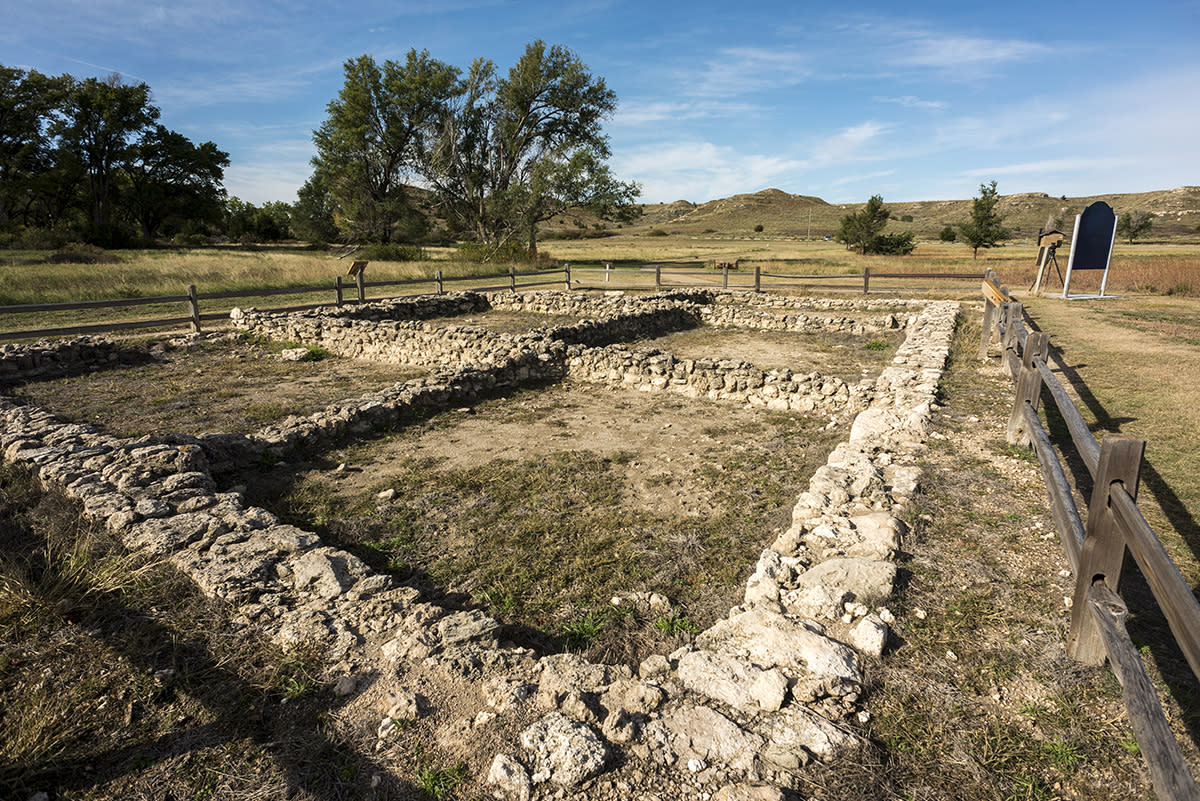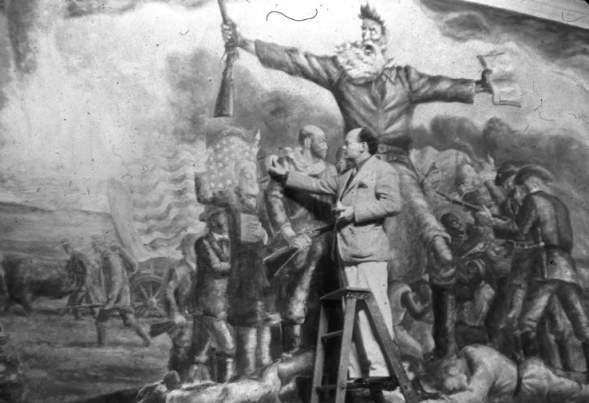
It’s a Southwest-style ruin where the deer, as well as the squirrels and the beavers, roam.
What we know about one of the state’s most widely studied and important archaeological sites begins with hungry squirrels.
According to stories passed down in Scott County and retold by Dennie Siegrist of the Scott County Historical Society, it was 1888 when farmer Herbert Steele noticed squirrels scratching through unplanted dirt on his farm and discovering a mother lode of maize. Digging around the area, Steele recovered pieces of pottery and objects curious enough to summon experts at the University of Kansas. From 1897–1899, a team from KU carried out the first excavations and declared that the site was undoubtedly what remained of a Pueblo community, most likely “El Cuartelejo,” a settlement of war refugees who had fled Spanish power in the Southwest and were forcibly returned by an armed Spanish detachment.
Until the past few years, it was largely thought that El Cuartelejo (variously spelled El Quartelejo or El Cuartalejo) was created by one or two groups of Pueblos who left their home in the mid-to-late 1600s to escape Spanish swords, steels and conversions. They would have traveled at least 450 miles, passing from steep inclines to the plains, until they arrived in a valley near present-day Lake Scott State Park, an area sheltered by hills and lush with springs.
The 19th-century KU excavation teams marveled at this hidden valley on the prairie that supported a population of woodland creatures and even a healthy community of beavers.
Rex Buchanan, director of the Kansas Geological Survey, says the valley remains a “spectacular” spot in an otherwise arid region. “There is water all up and down that valley,” says Buchanan. “I think the significance of those locations along the prairie, with the growth of vegetation and wildlife that comes with it, would have made people know about it.”
According to the standard narrative, in this fertile spot, the Pueblos grew crops and fashioned local clay and limestone rock into a structure that mimicked their traditional adobe homes. Architecturally, this building would be the very first mish-mash of Prairie vernacular and Pueblo revival—historically, it is the most northern and eastern Pueblo settlement yet discovered and the oldest extant settlement in what is now Kansas. Partly for this reason, the site has been recognized as a National Historic Landmark. Additionally, preservation efforts began in October 2015 to form a private-public partnership between the Scott State Park Historic Preservation and Development Committee and the Kansas Department of Wildlife & Parks to protectively enclose the ruins and build an interpretative center museum around them.

But more than 125 years and five extensive archaeological expeditions after the accidental discovery of El Cuartelejo, scientists are still trying to define the legacy of the lost community. New insights continue to emerge.
In 2014, a group of researchers led by Margaret Beck and Sarah Trabert analyzed the structure of the El Cuartelejo pottery and concluded they were created by Pueblo potters living in the region. An upcoming 2016 paper by the same scholars, joined now by David Hill and Matthew Hill, suggests that Pueblo potters arrived individually or in small numbers much earlier than previously thought. The Pueblo community might have been a continuation of inter-marriages, trading and settlement with other Plains Indians communities (going back perhaps to the mid-16th century) that then perhaps welcomed a group of Pueblo people joining the region during the late 1600s and early 1700s when they were battling Spanish control in the Southwest.
“The key implication here is that these Southwest groups did not just show up for a short time period and then leave (or get sent back to the Southwest as some historical accounts used to argue). The groups living in this region stayed in the area. They became part of the local area and were not simply short-term migrants,” says Matthew Hill.
Additionally, this team has used ground-penetrating radar techniques—the same procedures that recently revealed the extensive underground network of rock formations around Stonehenge—to study the surrounding area. Further studies are planned to reveal the extent of the pueblo-like settlements, as well as what might be under, above or surrounding them.
Pueblo historian Tito Naranjo has noted that the Taos Pueblo have passed down stories of traditional buffalo hunts, suggesting that their people—and not just one group of war refugees—spent extensive time throughout the Plains.
Mary J. Adair, who has studied El Cuartelejo extensively as senior curator at the KU Natural History Museum, suggests that advances in DNA research might soon enable a determined researcher to return to the charred corn from the site and conduct additional studies to see if the corn retains some genetic traits similar to varieties used specifically in rituals among Native communities in the Southwest—adding biological history to the extensive archaeological, anthropological and documentary studies.

Even if future studies would reveal nothing more than what we know now, El Cuartelejo would remain a crucial part of Kansas heritage.
State archaeologist Robert J. Hoard points to El Cuartelejo as a historical collision point of civilizations. “You have the French and the English from the east and the Spanish from the Southwest, fighting for control. And here you have the Pueblo Indians and the Plains Indians at El Cuartelejo, right in the middle of this, all caught up in a little patch of ground in a state park in Kansas,” says Hoard.
Donald Blakeslee, an archaeological anthropologist at Wichita State University who is recognized as a leading authority on pre-European settlements in Kansas, notes that El Cuartelejo is an extant representation of many more buried and forgotten communities that populated Kansas before pioneer wagons arrived—a reminder that nations and people have long called the area home.
But perhaps the most enduring legacy, notes Buchanan, might be the region itself. After all, whoever settled the region, whenever they arrived, probably did so because of the valley’s beauty and generous natural resources. That surprising beneficence of nature is something that a group of Pueblos might have recognized at the end of a long march across mountain ranges and plains. And it is something we continue to witness today, in an area where squirrels roam, where the local high school mascot is the “Beaver” in testimony to a natural woodland wonder in the heart of the Midwest.
Visiting El Cuartelejo
The pueblo-style remains of El Cuartelejo are located in Scott Co, on the grounds of Lake Scott State Park, approximately 15 miles north of Scott City or 42 miles south of the junction where Interstate 70 crosses U.S. Route 83.
Nearby sites of Interest
Historic Lake Scott State Park
This park features more than 1,000 acres of public land and includes boating, hiking and horseback riding.
Battle Canyon
This is the site of the last known battle (Sept. 27, 1878) in Kansas between Native Americans and American settlers.
El Quartelejo Museum
Located in Scott City, the museum tells the history of the pueblo-style ruins and the surrounding region. Through the Scott County Historical Society, the museum offers regular bus tours of El Cuartelejo, Battle Canyon, the Steele home and observations of bison herds. Tours are free, but reservations should be made in advance. elquartelejomuseum.org/museum
Jerry Thomas Gallery
Adjacent to the El Quartelejo Museum, this gallery features the Western and wildlife art of Jerry Thomas.
Monument Rocks
The state’s stunning natural rock formation, located on private land but currently open to the public, is approximately 25 miles north and east of El Cuartelejo.
Ways to Stay Connected
Read more about Kansas History
View ALlBlack History Trail of Geary County
Mar 08, 2024Jim Sands, President of the Black History Trail of Geary County / Photography by Nick Krug A county… Read More
Quindaro: A Great, Nearly Lost City of Free Peoples
Mar 07, 2024Photography by Andrea LaRayne Etzel & Carter Gaskins Quindaro was an abolitionist frontier city… Read More
From the Archives: Remembering John Steuart Curry
Jan 15, 2024Editor's Note: This article was originally published in the winter of 1992 by Don Lambert… Read More
From the Archives: Birth of the Helicopter
Jan 08, 2024Editor’s Note This article was originally featured in the winter issue of 1983 by Joan L… Read More
From the Archives: Kansas Outlaws
Oct 05, 2023The Sunflower State is known for its famous lawmen—but its infamous villains are legendary as… Read More









